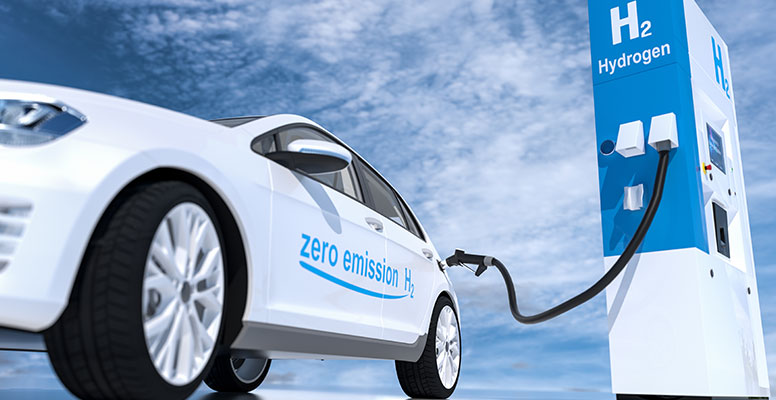“Do we want to be part of this energy revolution? We could have this wonderful opportunity coming out of this COVID-19 crisis.” JCB heir Jo Bamford, speaking last month to hydrogen news service H2 View, was optimistic about the potential of hydrogen to transform UK transport.
This sense of optimism about hydrogen’s potential now seems to be shared by transport secretary Grant Shapps, who has had a change of heart in recent months. In April, the Hydrogen All-Party Parliamentary Group wrote to him urging him to get over his “misjudged bias” against hydrogen. (It was signed by 40 representatives of various different organisations.) By June, Shapps was revealing plans for a “hydrogen bus town”, to be trialed soon.
Meanwhile, a recent European Commission report describes hydrogen as “essential to support the EU’s commitment to reach carbon neutrality by 2050 and for the global effort to implement the Paris Agreement while working towards zero pollution.”
Independent UK body the Committee on Climate Change (CCC) says that its net-zero scenarios all require greater use of hydrogen. But will hydrogen actually help us get to net zero – and how?
Areas where hydrogen can help
Hydrogen in transport
Hydrogen fuel cells generate electricity through an electrochemical reaction, not through combustion. The only products of that reaction are electricity, heat, and water, making hydrogen a zero-emissions fuel.
Unlike electric vehicles, hydrogen vehicles don’t need to be recharged because they don’t have batteries; they are fuelled through a nozzle that delivers compressed hydrogen into the vehicle’s pressure tank, a process that takes about as long as filling up with petrol. Hydrogen vehicles can also do more miles between refuels than electric vehicles can go between charges. For these reasons, the CCC predicts that hydrogen will also be important for decarbonising the operation of long-distance HGVs and ships. In the second half of the 2020s, we will need to make a decision about the best way to switch to zero-emissions HGVS, so we will need to have already trialed hydrogen HGVs along with battery-electric HGVs and other options in order to make the best decision.
Hydrogen in industry
According to the CCC, we will need to begin large-scale hydrogen production (with carbon capture and storage) this decade if we are to stay on track for net zero. By the 2030s there should be “widespread use of hydrogen in the industry”. To get to that point, we should be doing a lot more to explore ways to switch industrial technologies to hydrogen.
The European Commission’s new industrial strategy envisions that hydrogen could replace fossil fuels in the carbon-intensive industrial process such as steel-making or manufacturing chemicals. In steel-making, zero-carbon processes based around the use of hydrogen may eventually be possible if there is sufficient investment in developing them. Experts from the hydrogen sector recently called for the UK to come up with its own hydrogen strategy for the industry.
Hydrogen for heating our homes
There are two main options for decarbonising our heat and hot water generation: electrifying all homes and replacing traditional boilers with electric heat pumps, or decarbonising the gas supply. Government figures show that around 85% of UK homes have gas central heating, and the 2020 Future of Fuel report from Worcester Bosch suggests that electrifying every home could cost three times as much as decarbonising the gas supply. Worcester Bosch is now working on what may be the world’s first hydrogen-fuelled domestic boiler.
However, that 85% figure hides a lot of regional variation. In Northern Ireland, only about 24% of households are connected to the gas grid, while Scottish and Welsh households are also less likely to be connected to the gas grid than English homes. This means that even if we managed to convert the UK gas network from natural gas to hydrogen, many areas would miss out on the opportunity to decarbonise their domestic heating. We will need multiple different measures to cut the emissions from UK homes; hydrogen fuel is just one of them.
Hydrogen for energy
Hydrogen also has a role to play in supporting the transition to renewable electricity. Future energy systems could use hydrogen as a backup, transforming electricity into hydrogen when renewables are generating more energy than we need, then unlocking the stored power when we need it.
The challenges
Most hydrogen isn’t green – yet
Unfortunately, we have a long way to go before hydrogen can play its part in getting the UK to net zero. For hydrogen to be a genuinely carbon-neutral fuel source, it must be produced from clean sources. Unfortunately, over 90% of global hydrogen production involves fossil fuels. The European Commission estimates that hydrogen production results in the release of 70 to 100 million tonnes of CO2 in the EU every year. The CCC warns: “Producing large volumes of hydrogen from natural gas could lock the UK into a path with insufficient emissions reductions by 2050.” Even using carbon capture and storage (CCS) to cut down on overall emissions won’t fix this, so the only answer is to switch to hydrogen from greener sources.
Cost-competitiveness
Electricity-based hydrogen is produced by getting an electrical current to split water into its component elements of hydrogen and oxygen. When the source of the electricity is renewable, you can describe what you’re producing as renewable hydrogen. The greenhouse gas emissions for the production of renewable hydrogen are close to zero, but the problem is cost. The recent European Commission report on hydrogen found that fossil-based hydrogen costs around 1.5 €/kg to produce, while renewable hydrogen is in the range of 2.5-5.5 €/kg.
However, the costs of producing renewable hydrogen are falling. In areas of the EU where renewable electricity is cheap, renewable hydrogen may become cost-competitive with fossil-based hydrogen by 2030.
As for the UK, the CCC points out that most projects to reduce emissions have their costs offset by reduced fuel costs, but sadly hydrogen is an exception. Investing in clean hydrogen will require “both increased upfront spend and higher fuel costs”.
No joined-up strategy
The CCC points out that when a solution cuts across different systems (for example, the way that hydrogen has a role in electricity generation, transport, industry, and heating) a fully integrated policy is crucial. At the moment, the UK does not have an integrated policy for how it will support the increased production of green hydrogen and use this to decarbonise our homes, industry, and transport.
The UK government is currently funding five innovative hydrogen production projects, including two projects that are described as “Europe’s first-ever low carbon hydrogen production plants”. One is on the banks of the Mersey and the other will be near Aberdeen. The third project near Grimsby will use wind power to produce hydrogen through electrolysis. All this innovation has the potential to make the UK a world leader in clean hydrogen, but it can’t get us to net zero unless it is part of a realistic long-term strategy with the necessary funding in place.

